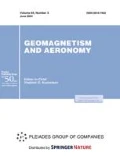Abstract
Calculated insolations of the Earth are analyzed. The main trends in the modern solar climate change are identified: increased latitudinal contrast and smoothed seasonal differences. The correlation of the meridional insolation gradient with the average annual energy transfer in the ocean–atmosphere system is revealed. The features of changes in the annual and semiannual meridional insolation gradients and the correlation of latitudinal regions of maximum changes with the spatial localization of circulation cells (Headley, Ferrel, and Polar cells) and the regions in which vortex formations are generated and developed (tropical and extratropical cyclones) are revealed. The possibility of a link of between the decrease in the inclination of the Earth’s rotation axis and an increase in the meridional insolation gradient with an increase in climate turbulence is noted.






Similar content being viewed by others
REFERENCES
Fedorov, V.M., Solnechnaya radiatsiya i klimat Zemli (Solar radiation and Climate of the Earth), Moscow: Fizmatlit, 2018.
Fedorov, V.M., Earth’s insolation variation and its incorporation into physical and mathematical climate models, Phys.-Usp., 2019, vol. 62, no. 1, pp. 32–45. https://doi.org/10.3367/UFNr.2017.12.038267
Fedorov, V.M. and Kostin, A.A., Calculation of the Earth’s insolation for the Period from 3000 BC to 2999 AD, Protsessy Geosredakh, 2019, vol. 2, pp. 254–262.
Kondrat’ev, K.Ya., Radiatsionnye faktory sovremennykh izmenenii global’nogo klimata (Radiation Factors of Modern Global Climate Changes), Leningrad: Gidrometeoizdat, 1980.
Lorenz, E.N., The Nature and Theory of the General Circulation of the Atmosphere, World Meteorological Organization, 1967; Leningrad: Gidrometeoizdat, 1970.
Milanković, M., Mathematische Klimalehre und astronomische Theorie der Klimaschwankungen (Mathematical Science of Climate and Astronomical Theory of the Variations of the Climate), Berlin: Borntraeger, 1930; Moscow–Leningrad: GONTI, 1939.
Monin, A.S., Vvedenie v teoriyu klimata (Introduction to the Climate Theory), Leningrad: Gidrometeoizdat, 1982.
Monin, A.S. and Shishkov, Yu.A., Climate as a problem of physics, Phys.-Usp., 2000, vol. 43, no. 4, pp. 381–406.
NASA, Jet Propulsion Laboratory, California Institute of Technology (JPL Solar System Dynamics). http://ssd.jpl.nasa.gov.
Palmén, E. and Newton, C., Atmospheric Circulation Systems, New York: Academic, 1969; Leningrad: Gidrometeoizdat, 1973.
Peixoto, J.P. and Oort, A.H., Physics of climate, Rev. Mod. Phys., 1984, vol. 56, pp. 365–429.
Voeikov, A.I., Meteorologiya (Meteorology), St. Petersburg: Izdanie kartograficheskogo zavedeniya A. Il’ina, 1903.
Author information
Authors and Affiliations
Corresponding author
Additional information
Translated by V. Arutyunyan
Rights and permissions
About this article
Cite this article
Fedorov, V.M. Features of the Earth’s Solar Climate Changes in the Present Epoch. Geomagn. Aeron. 60, 993–998 (2020). https://doi.org/10.1134/S0016793220070117
Received:
Revised:
Accepted:
Published:
Issue Date:
DOI: https://doi.org/10.1134/S0016793220070117


